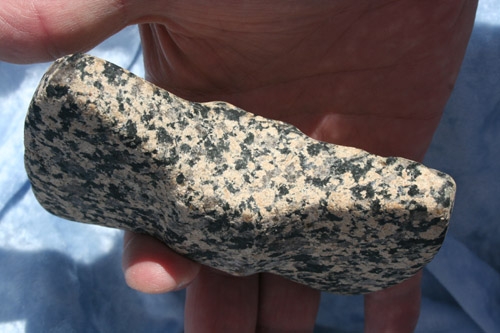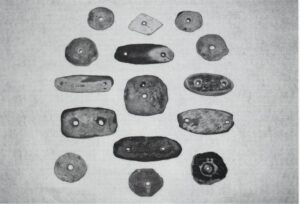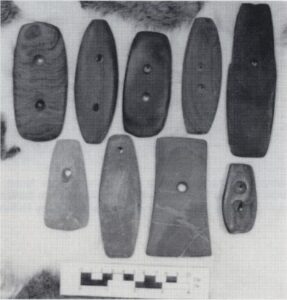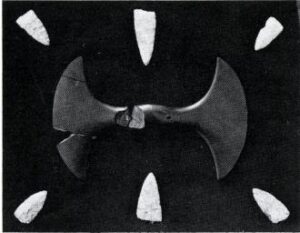by V Gary Henry, Asheville, North Carolina
Originally Published in the Central States Archaeological Journal, Vol.56, No.4, pg.200
Originally Published in the Central States Archaeological Journal, Vol.57, No.2, pg.72
In 1978, I located to Asheville, North Carolina, where I still reside. Several stories from this time period are remembered. One of the most rare artifacts in this area is a complete bannerstone (atlatl weight). I have found numerous pieces, usually halves broken at the weakest point at the perforation. In my earliest artifact hunting trips in this new area I walked the fields along several streams in the area to locate sites. At times my wife would let me out on one side of a creek, cross the creek by road, and then parallel the creek on the only road, which was on the opposite side of the creek from the side I was hunting, and then cross back over the creek at the next perpendicular road to the creek and pick me up. On one occasion a farmer’s son accompanied me in checking out some fields on his father’s farm. During our walking my companion mentioned a “tomahawk” he had found. Further discussion indicated the artifact had a hole through it so I immediately suspected it was a bannerstone. When we finished hunting the boy retrieved the “tomahawk” and gave it to me. It was indeed a bannerstone (Figures 1-2, center). I reached into my billfold and gave the boy what paper money I had, in exchange for the bannerstone, which I think was $10. This was my first banner-stone. It appears to be an Early Archaic winged type dated at 5800 to 3800 B.C. It is 4 inches long, 1 7/8 inches wide and 1 1/8 inches thick. The perforation is 1/2 to 5/8 inch in diameter.
My first finding of a traditional bannerstone not broken in half occurred on May 22, 1994, on the sixth visit to a site in Buncombe County, North Carolina. I saw the perforation and could not believe my luck (figures 1,2 top). However, in turning it over I discovered it was broken but not broken completely through the perforation. I had about three fourths of the artifact, which I still considered a significant find. I believe it is a Middle Archaic Paneled bannerstone dated from 4300 to 3500 B.C. It is 2 3/4 inches long, 1 13/16 inches wide and 1 3/8 inches thick, and the perforation is 5/16 inch in diameter. I have found 89 artifacts on this site in seven visits from December 22, 1986, through May 11, 1997.
Then, on April 5, 1997, on my fourteenth visit to another site in Buncombe County I found my first complete traditional bannerstone (Figures 1-2 Bottom). The drilling was only just begun and not completed. Because of the difficulty of finding complete bannerstones in this area, I consider this one of my best finds. It is also considered a Paneled type bannerstone from the Middle Archaic period dated at 4300 to 3500 B.C. It is 3 inches long, 1 15/16 inches wide and 1 3/16 inches thick. The perforation is 3/8 inch in diameter. I have found 1,167 artifacts at this site in 27 visits from April 24, 1996, through July 13, 2000, including diagnostic points from all time periods except the Paleo and Late Mississippian.”Used by Permission of the Author”
To learn more about or to join the Central States Archaeological Society, click here:CSASI.org





